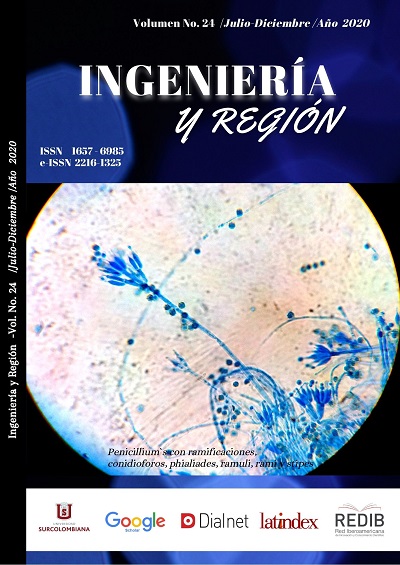Determination of the lethal concentration average LC (50-96) of the Bocachico and Capaz fish to the fungicide Cyproconazole used in coffee growing in the department of Huila
##plugins.themes.bootstrap3.article.main##
Colombia evidences one of the main environmental problems and this refers to the indiscriminate use of pesticides in mining activities, dumping of wastewater, industrial activities, and inadequate agricultural practices, these compounds can reach bodies of water by leaching or runoff. The fish have the capacity to store in their organism a greater concentration of these compounds in comparison with the environment, the reason why they are an important indicator of contamination. The objective of the present study was to determine the lethal concentration average LC (50-96) of the fish species Prochilodus magdalenae "bocachico" and Pimelodus grosskopfii "capaz" under the action of the active substance Cyproconazole fungicides used in coffee growing in the department of Huila. The bioassays were conducted at the Experimental Station of Hydrobiological Resources of the Surcolombiana University, using 10 bocachico’s juveniles under the concentrations of 12.5, 14.0, 15.5 and 17.0 mg/L and 8 capaz’s juveniles under the concentrations of 6.0, 7.0 8.0 and 9.0 mg/L, three replicates for each concentration, mortality was observed for 3, 6, 24, 48, 72 and 96 hours of exposure. It was found that the CL (50-96) for bocachico is 15.218 mg/L and for the capaz is 6.864 mg/L, evidencing that Cyproconazole is moderately toxic to the bocachico and much more toxic to the capaz.
These results were compared with other studies with the same fungicide or with the same species showing similarities with some invertebrates and with the glyphosate herbicide. It is argued that in the long term these pesticides can potentially disturb freshwater fish species, their commercialization, and therefore the economy of fishing families in the area. It is recommended to monitor the application of pesticides in agricultural areas to avoid impacts on aquatic ecosystems.
Downloads
##plugins.themes.bootstrap3.article.details##
Alvarado, H. (1998). Evaluación biológica-pesquera del embalse de Betania (Huila), Santa Fé de Bogotá. INPA. 14-31.
Cardona, N. & Pino, L. (2016). Exposición laboral a plaguicidas en una muestra de trabajadores de café y gulupa mediante una matriz de tarea-exposición en el municipio de Jericó, Antioquia entre enero y mayo 2016. Universidad de Antioquia. Facultad Nacional de Salud Pública Héctor Abad Gómez. Medellín.
Do Carmo Langiano, V., & Martinez, C. B. (2008). Toxicity and effects of a glyphosate-based herbicide on the Neotropical fish Prochilodus lineatus. Comparative Biochemistry and Physiology Part C: Toxicology & Pharmacology, 147(2), 222-231.
Gómez, Á. G. G., Pérez, A. X. P., Bonilla, L. M. V., & Cuenca, L. V. C. (2015). Presencia de mercurio en la especie Pimelodus grosskopfii “Capaz” en el departamento del Huila. Ingeniería y Región, (13), 47-56
Henao, B., Palacio, J. A., & Camargo, M. (2005). Evaluación genotóxica de los plaguicidas Cipermetrina y Diazinón en Tilapia Roja (Oreochromis sp.). Actualidades Biológica, 27(82), 43-55.
Ikpesu, T. O. (2015). Assessment of occurrence and concentrations of paraquat dichloride in water, sediments and fish from Warri River Basin, Niger Delta, Nigeria. Environmental Science and Pollution Research, 22(11), 8517-8525. DOI: https://doi.org/10.1007/s11356-014-3993-2
Jiang, H., & Fine, J. P. (2007). Survival analysis. In Topics in Biostatistics (pp. 303-318). Humana Press. DOI: https://doi.org/10.1007/978-1-59745-530-5_15
Mancera, N. J., & Álvarez, R. (2006). Estado del conocimieno de las concentraciones de mercurio y otros metales pesados en peces dulceacuícolas de Colombia. Acta Biológica Colombiana, 11(1), 3-23.
Montoya, A. (2016). Huila, eje del nuevo mapa cafetero de Colombia, federación nacional de cafeteros. https://www.federaciondecafeteros.org/particulares/es/buenas_noticias/huila_eje_del_nuevo_mapa_cafetero_colombiano/ Consultado el 27 de diciembre de 2016.
Oficina de las Naciones Unidas contra la Droga y el Delito. (2010). Problemática ambiental y la utilización de agroquímicos en la producción de coca., Informe analítico. Vienna, Austria: UNODC. http://www.unodc.org/documents/peruandecuador//Informes/InformesAnaliticos/Informe_Analitico_Agroquimicos-pdf. Consultado el 18 oct 2017.
Olaya, A., & Sánchez, M. (2005). Editores. Del Macizo Colombiano al desierto La Tatacoa, la ruta del río Magdalena en el Huila. Neiva: Universidad Surcolombiana, Corporación Autónoma del Alto Magdalena CAM. 524p.
Oliveira, F. A., Reis, L. de P., Soto, B., & Melo, M. (2014). Research of fungicides, acaricides and herbicides in fish Prochilodus costatus in São Francisco River Brazil. Toxicology Letters, 229, S123. DOI:10.1016/j.toxlet.2014.06.440
Organización Panamericana de la Salud OPS. (1978). Criterios de salud ambiental No. 1. Mercurio. Organización Panamericana de la Salud Publicación Científica 362. Washington D.C. (USA).
Palacio, J., & Aguirre, N. J. (2002). Efectos tóxicos de la exposición aguda de Prochilodus magdalenae a cloruro de mercurio. Actualidades Biológicas, 24(77), 123-128.
R Core Team (2018). R: A language and environment for statistical computing. R Foundation for Statistical Computing, Vienna, Austria. URL http://www.R-project.org/.
Rodrigues, A. L., Bellinaso, M. L., & Dick, T. (1989). Effect of some metal ions on blood and liver delta-aminolevulinate dehydratase of Pimelodus maculatus (Pisces, Pimelodidae). Comparative biochemistry and physiology. B, Comparative biochemistry, 94(1), 65-69. DOI: https://doi.org/10.1016/0305-0491(89)90012-6
Sánchez, M., León, V. & Reyes, W., (2000). Evaluación de la pesca de especies nativas en el alto rio Magdalena, departamento del Huila (Colombia). Actualidades Biologicas 22 (73), 215-223.
Saraiva, A. D. S. (2016). Avaliação da toxicidade de Tiametoxam, Ciproconazol e Paraquat em invertebrados aquáticos. http://hdl.handle.net/11612/377. Consultado el 15 de Julio del 2018.
Tabassum, H., Dawood, A. Q., Sharma, P., Khan, J., Raisuddin, S., & Parvez, S. (2016). Multi-organ toxicological impact of fungicide propiconazole on biochemical and histological profile of freshwater fish Channa punctata Bloch. Ecological indicators, 63, 359-365. DOI: https://doi.org/10.1016/j.ecolind.2015.11.052
Zhang, J., Zhang, J., Liu, R., Gan, J., Liu, J., & Liu, W. (2015). Endocrine-disrupting effects of pesticides through interference with human glucocorticoid receptor. Environmental Science & Technology, 50(1), 435-443. DOI: 10.1021/acs.est.5b03731
Zhang, W., Cheng, C., Chen, L., Di, S., Liu, C., Diao, J., & Zhou, Z. (2016). Enantioselective toxic effects of cyproconazole enantiomers against Chlorella pyrenoidosa. Chemosphere, 159, 50-57. DOI: https://doi.org/10.1016/j.chemosphere.2016.05.073
Zarn J A., Bruschweiler B J., & Schatter J. (2003). Azole Fungicides Affect Mammalian Steroidogenesis by Inhibiting Sterol 14 α-Demethylase and Aromatase. Environ Health Perspect 111:255-261. DOI:10.1289/ehp.5785


















